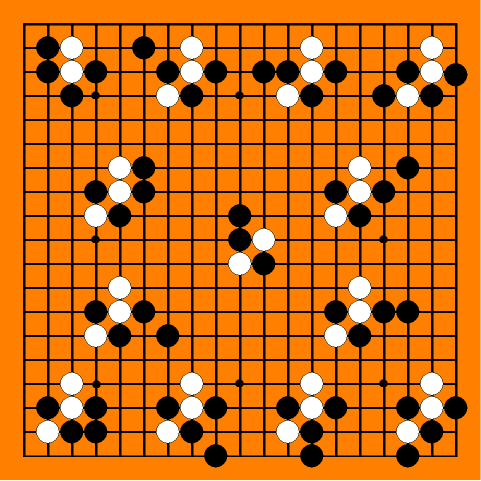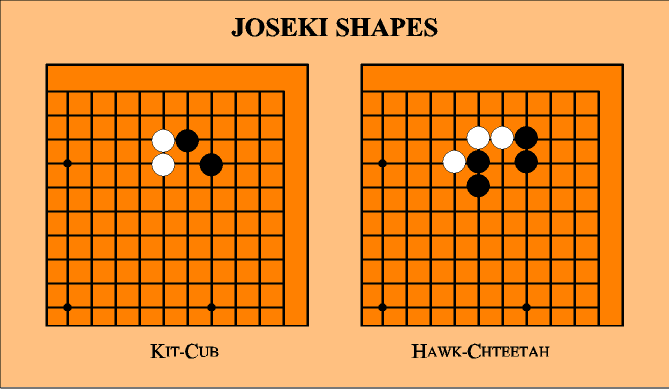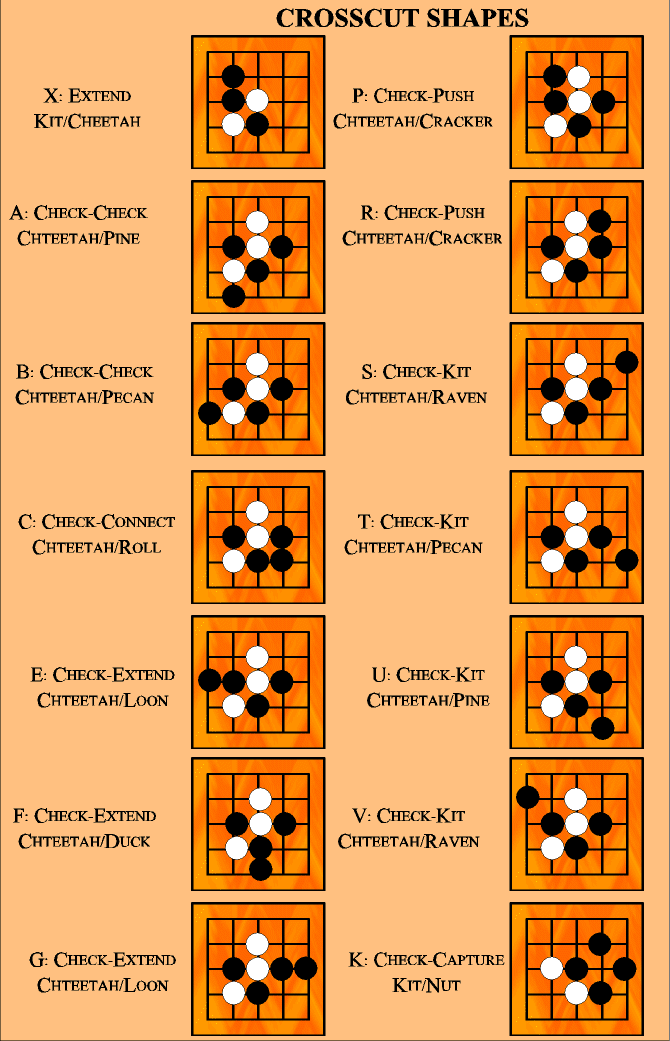GO In The West
BADUK In Korea
IGO In Japan
WEIQI In China
© Craig R. Hutchinson, 3 April 2007

A Contest of
Life, Liberty and the Pursuit of Happiness
| GO RANKS AND LEVELS OF PROFICIENCY AND OTHER ACTIVITIES | |||||||
| Go Ranks | Proficiency Level | Games Played | Applied Knowledge | Education Level | Military Rank | Judo/ Karate Rank | Dance/ Skate Level |
| 1-9 Dan | Grand Master | 10,000 | Refined Integrated Strategy & Tactics | Doctor of Science | General | Black | Star |
| 1-7 dan | Master | l,000 | Integrated Strategy & Tactics | Master of Science | Colonel | Red | Gold |
| 9-1 kyu | Expert | 75 | Strategy & Tactics | Bachelor of Science | Lt Colonel | Brown | Silver |
| 18-10 kyu | Apprentice | 25 | Tactics | High School Diploma | Major | Blue | Silver |
| 27-19 kyu | Novice | 15 | Tactics | Junior High | Captain | Yellow | Bronze |
| 36-28 kyu | Beginner | 5 | Rules | Grade School | Lieutenant | White | Bronze |
|
Go Ranks denotes the Go player's strength. Proficiency Level: Grandmaster is professional; Other are amateur. Games Played denotes approximate number to reach the level. Number depends on talent, dedication, opposition strength. | |||||||
Players learning to play Go
may have the following questions
about continuing to play the game.
How much will I have to learn?
How difficult will it be?
How long does it take?
Do I have the talent (creative or artistic aptitude),
the dedication (capacity and desire)
and time required to play the game?
In the end will it be worth the effort?
These questions are natural,
for similar ones are asked by most travelers
taking an unknown path.
In order to understand the path
to learning and enjoying Go,
a brief survey of
Go Ranks and Levels of Proficiency (GRLP)
will prove useful.
An amateur player's progress in learning to play Go
is measured on a scale from 36 kyu (beginner) to 9 dan (master).
GRLP defines six levels of proficiency for the numerical ranking of Go players
and compares the levels of proficiency to other activities.
It is similar to the view of a mountain path
seen from the top of a mountain
where turns and dead ends are revealed.
At the same time,
the true length and difficulty of the path is made visible.
If one compares the path
to the years of effort required to earn a
High School,
Bachelor of Science,
Master of Science,
or Doctor of Science degree,
one might be tempted to give up.
But if Go players take each step
as it comes at their own pace,
then they smoothly and inevitably find their own level.
Just as all students do not go on to college,
all Go players do not become masters.
Yet, even those who peak at some lesser level of proficiency
can enjoy the beauty, pleasure, and challenge of Go.
There have been cases of players who have progressed
from complete beginner to amateur one dan in a single year,
including one five year old girl!
But this is rare and requires an unusual combination
of talent, dedication and professional level competition.
A much slower rate of progress is more common,
but almost anyone can expect to reach
7-5 kyu strength within 12 months
if they apply themselves.
Beyond this strength prediction is difficult,
and progress is a highly individual matter
depending on talent and dedication
as well as dan level competition.
The levels of probable playing strength
are significant stages of development
and, as shown in GRLP,
are only approximate indications.
Different individuals will reach the levels
earlier or later than that shown.
In order to begin understanding the levels of proficiency,
Subject Areas for Studying Go (SASG)
provides the six general subject areas for studying Go.
SASG indicates at what level of proficiency
a Go player begins to understand the six areas.
In addition, books in English
that are available and recommended
for studying the various areas
are cross referenced with the bibliography.
Further, the books are arranged
according to level of proficiency
in which the books should be read and thoroughly understood.
Go is a game of surprising contrasts and infinite depth
which has a structure of rules
simple enough for a child to comprehend,
but which generate complexities sufficient to challenge anyone.
Just as one should not reasonably expect
to solve calculus problems
before mastering arithmetic and algebra,
one should not expect to play master level Go
until the three stages of the game,
as well as tactics and strategy,
are understood.
Although many players recognize these facts,
they are uncertain as to how to efficiently proceed
in acquiring the necessary knowledge indicated in SASG.
First let's look at the amateur levels of play in more detail.
Beginner Level:
The beginner level is an introduction to the game
and consists of learning the rules
as well as the mechanics of play
such as counting liberties, check, capture, repeat, etc.
This is similar to learning
a new language or the rudiments of any new skill
and is a necessary prerequisite.
If the first few games are played
on a 5x5 or 7x7 line grid,
it will help to speed up this process
and require approximately five games.
Novice Level:
The novice level is marked by total confusion,
and is where the timid will quit.
The grid seems vast
and novices have no idea where to play their stones,
cannot see their foe's threats,
often cannot tell if their stones are alive or dead,
and do not recognize when the game is over.
If they have talent for Go,
a good instructor,
and/or the dedication for study,
this crucial level may be passed over in 10 to 25 games.
If the games are played on a 9x9 line grid,
it will prove helpful in overcoming this level.
When they rise above this level,
they are apprentice Go players,
and it is here where true enjoyment and study begins.
Apprentice Level:
From this level on,
the rate of progress is determined by three factors:
talent,
dedication (evidenced by study and play),
and the strength of the opposition (where one sharpens their skills).
In the beginning
the players continue to take black
with a large handicap in every game,
and white continues to cut the black formations to ribbons.
The goal should be to win three games in a row
with four handicap stones using either
Hawk-Cheetah or Kit-Cub joseki
on a 13x13 line grid
before moving up to the 19x19 line grid.
As they learn handicap joseki
and slowly but steadily become able to create safe formations,
the handicap will be reduced
until it seems that it can be reduced no further.
This will represent the limits and skill
of a purely defensive game.
Their rank is then between 15-9 kyu,
depending upon the strength of the opposition being played.
To progress further it will be necessary
to drop a purely defensive game,
develop fuseki,
and become more offensively oriented.
However, they will now begin to lose
at handicaps in which they won before.
It is essential that they persist
in their attempt to increase the offensive
and temporarily ignore the results
until the new strategy is understood.
Further, a more thorough study of handicap fuseki,
and a better understanding of end game is required.
When the players succeed
they will have reached the expert level.
Expert Level:
The last level to be overcome in developing Go skill
is the expert level.
It is in this level
that extensive even-game (i.e. non-handicap) play is developed.
It may seem strange,
but even at a large Go club with many members
even game is the exception and quite rare,
except among the highest ranked dans.
Thus it requires special effort
in order to reach the master level.
Extensive study of the even game in the beginning stage
as well as continuing study
in the other stages and tactics and strategy
is essential in this effort.
The first introduction to even game joseki
will probably come in games
where a handicap of three stones or less is taken.
However, there is still a large difference
in the fuseki
between this and a non-handicap state
which should not be minimized.
Master Level:
This is the level amateur Go players never exceed,
although the strength of the opposition
will continue to improve as they do.
In an even game,
the balance between offense and defense needs to be exact,
and the opposition at precisely the same skill level,
so that it provides the ultimate challenge.
Go players who learn without benefit of extensive contact
with strong players
have the advantage
that they play as white at an early level,
and therefore develop no psychological barriers.
But this is more than offset by the fact that
they also learn inconsistent tactics and strategies
which will have to be unlearned
when they encounter stronger opposition (dan level).
In contrast,
the Go player who has had extensive experience
with taking large handicaps from dan level players
has little to unlearn and only has the subconscious barrier
of role reversal to overcome.
The trick in learning to play white against a large handicap
is to plunge in with confidence,
strike at the vital points,
and recall how white used to play against you.
A few players take to this quite naturally
and play some of their best games under these conditions.
Now with more understanding of the levels of play,
the next question is how to traverse them.
In other words,
what material should be learned and in what order.
Formal study as well as grid playing experience
is necessary to reach the higher levels of proficiency.
The idea is to build with the knowledge of the past.
Study is essential for everyone,
and there is no upper limit
to the return you can receive
from increased effort in this direction.
Thus let your interest and inclination,
as well as the SASG
be your guide for study.
To play Go strongly,
learn how to
Reckon Evaluate Analyze Diagnose
Shapes, Points, Acts, Realms, Kens, Styles
via
Elements, Principles, State Esteem, Proverbs, Art,
and how to apply your Strategies and Tactics.
It takes time and practice,
similar to learning a language.
Study one chapter or section a day
of the Apprentice Elementary Books 3.01 - 3.07,
and/or the Expert Intermediate Books 4.01 - 4.15,
until you have the Go Elements in your brain.
There is no short cut,
you will have to go through the books over and over again,
rotating them clockwise one fourth, each time,
so you can visualize and analyze the shapes
from four different views,
until you learn and can apply the Go Elements.
Play at least one game a day
putting your
Strategies and Tactics into practice
with the
Shapes, Points, Acts, Realms, Kens, Styles
via
Elements, Principles, State Esteem, Proverbs, Art.
Enjoy Your Good Premises!!!
| SUBJECT AREAS FOR STUDYING GO | |||||||
| Area of Study | Proficiency | Reference | |||||
| Introduction | Beginner | 1.01, 1.03, 1.06, 1.11-14 | |||||
| Novice | 2.03, 2.04, 2.05, 2.10 | ||||||
| Apprentice | 3.16, 3.18 | ||||||
| Strategy | Apprentice | 3.01, 3.08, 3.16, 3.19, 3.38 | |||||
| Expert | 4.17, 4.25 | ||||||
| Master | 5.05 | ||||||
| Tactics | Novice | 2.04, 2.12 | |||||
| Apprentice | 3.03, 3.10, 3.19, 3.23, 4.11-12 | ||||||
| Master | 5.08, 5.10 | ||||||
| --- Shapes | Apprentice | 3.03, 3.19, 3.39, 4.13, 4.26-27 | |||||
| --- Tesuji | Apprentice | 2.04, 3.03, 3.22, 3.36, 4.06, 4.24 | |||||
| --- Harass | Expert | 4.10, 4.25, 5.11 | |||||
| Proverbs | Apprentice | 3.21, 3.37, 5.06 | |||||
| Beginning Stage | Apprentice | 3.01, 3.02, 3.09 | |||||
| --- Handicap Games | |||||||
| --- --- Joseki | Apprentice | 2.04, 3.02, 3.19, 5.03 | |||||
| --- --- Fuseki | Apprentice | 2.04, 3.01, 4.15, 5.02, 5.10 | |||||
| --- --- Harass | Apprentice | 2.04, 3.05 | |||||
| --- --- Games | Apprentice | 3.07, 3.15, 3.17, 4.09 | |||||
| --- Even Games | |||||||
| --- --- Joseki | Apprentice | 3.02, 3.19 | |||||
| Expert | 4.02-04, 4.18-19 | ||||||
| Master | 5.03-04 | ||||||
| --- --- Fuseki | Apprentice | 3.14, 3.19-20 | |||||
| Expert | 4.01, 4.15, 4.18-19, 4.42 | ||||||
| Master | 5.05, 5.12 | ||||||
| --- --- Harass | Expert | 4.10 | |||||
| --- --- Games | Expert | 3.61-67, 4.16, 5.07, 5.09 | |||||
| Middle Stage | Novice | 2.11, 3.20 | |||||
| --- Life/Death | Apprentice | 3.04, 3.12, 4.08, 4.14, 4.40-41 | |||||
| --- Invasions | Apprentice | 3.19, 4.05 | |||||
| --- Reductions | Apprentice | 3.19 | |||||
| End Stage | Apprentice | 3.06, 3.20, 4.07 | |||||
| --- Shapes | Apprentice | 2.04, 3.06 | |||||
| --- Tesuji | Apprentice | 2.04, 3.06 | |||||
|
View Go Study for SASG Reference Bibliography or contact Hutch Phone: 703-698-9811 E-mail: crhutch@erols.com Net: http://users.erols.com/crhutch/go.html  
| |||||||